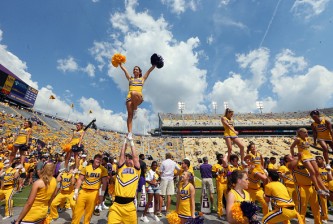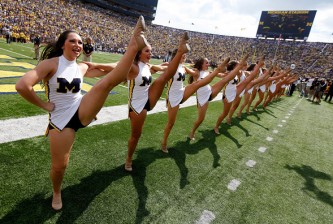We continue with the guest columns today. I hope you’re enjoying them. This comes from Greg Stanko from the public relations firm, Oglivy Public Relations in Washington, DC.
He writes about IndyCar’s TV contracts.
A lot has been made here and in other forums about how ESPN covers the NHL (or perhaps more accurately doesn’t cover it) since the League signed on with OLN back in 2005. Hockey fans feel that since the self-proclaimed Worldwide Leader doesn’t have the NHL broadcast rights, the lack of coverage is punishment for the League signing on with the competition.
If you think hockey fans are peeved, you should hear what fans of the Izod IndyCar Series think of ESPN – even though IndyCar and ESPN have a long standing relationship.
IndyCar’s television issue is instructive for most second tier sports and conferences. Today, they have the choice of signing up with NBC Sports Network or one of the other cable sports networks not headquartered in Bristol, Conn. and be a big fish in a small pond. Or, they can sign up with ESPN and hope to benefit from the network’s marketing might.
It may be hard for younger viewers to believe, but 20 years ago, IndyCar was more popular in terms of television ratings than NASCAR. The series had a bigger national (and international) footprint and many more sponsors. The Indianapolis 500, not the Daytona 500, was biggest race in America in terms of TV ratings.
And then in 1996, a civil war started in American open wheel racing. The formation of the Indy Racing League (IRL) led to a twelve-year period where the rival circuits bled fans, sponsors and money. By the time the two operations merged back together under the IRL banner in 2008, the sport was largely irrelevant to most fans. NASCAR had the “butts in seats,” the sponsors, the richer television contracts and the overall popularity. To add insult to injury, the Indianapolis 500, the one open wheel race most Americans could name, wasn’t even the most popular race in Indianapolis, having been surpassed by NASCAR’s Brickyard 400.
One of the first major deals the IRL made after reunification was its television contact. It hoped that a strong television contract would help it reconnect with tens of thousands of lost fans.
With the exception of a few months in 1996, the IRL had ABC/ESPN as its partner. However, ABC/ESPN offered the cash-strapped IRL barter deal for the cable contract. The IRL, needing the money, jumped at the money offered by Versus and moved the majority of its races to the upstart cable network under a ten-year contract. On the broadcast side, ABC/ESPN was the only bidder for the Indianapolis 500 and several other races so it kept that part of the contract.
Beginning in 2009, the open wheel fans faced a major dilemma.
On the one hand, Versus stepped up to the plate and produced a superior product. It brought back long-time ESPN auto-racing play-by-play man Bob Jenkins to anchor a well received broadcast team. Versus also found a jewel with analyst Jon Beekhuis. The broadcasts were technically excellent and Versus promoted the races throughout its schedule. The problem was nobody was watching. Versus’ inferior brand name and distribution meant race fans had to struggle to find the channel and, based on the ratings, not a lot of them made the effort.
On the other, ABC/ESPN treated IndyCar as its redheaded stepchild. Unlike the NBA and college football, there was no parallel programming on ESPN so the channel, with the exception of the Indianapolis 500, rarely went out of its way to promote the series. It also didn’t seem to put a lot of effort into the broadcasts. ABC/ESPN announcers Marty Reid and Scott Goodyear were significantly inferior to their counterparts on Versus. Mispronounced names and misidentified drivers were common. The tone of the broadcasts was flat. Technically, the races were even worse. More often that not, the producers botched shots, missed key moments and generally produced a poor product.
The neglect was also seen in the coverage ESPN gave the IRL on its other programs. Barring a spectacular crash, the Versus races rarely got coverage on SportsCenter, Around the Horn, PTI or the channel’s other programs. However, again with the exception of the Indianapolis 500, the ABC races were also ignored. One race made SportsCenter only because Danica Patrick, once the IRL’s biggest star, got into a post-crash screaming match with perennial back marker Milka Duno.
Fast forward to today. The IRL has morphed to become IndyCar. Versus has become the NBC Sports Network and, if anything, the coverage has gotten better. The network added Wally Dallenbach to the broadcast booth to work with Jenkins and Beekhuis and the curmudgeonly Robin Miller to the prerace program. Technically, the races are still top notch and the producers rarely miss a moment. Unfortunately, the ratings, while better, still aren’t as good as IndyCar wants, but they continue to improve.
On the broadcast side, fans were disappointed when ABC/ESPN kept the over-the-air rights when NBC chose not to bid. Fans are now resigned to more of the same inferior coverage and promotion though 2018.
As an example, after last weekend’s race in Detroit, ESPN not only deemed the race unworthy of coverage on its Sunday late night SportsCenter, but also did not include the race results on the ticker on the bottom of the screen. It did, however, manage to find time to cover the NCAA women’s softball semifinals and a Brazil-Mexico soccer friendly.
So what have we learned?
In essence, unless you are one of the big six (NFL, MLB, NASCAR, NBA, college football and college basketball), the benefits of signing up with ESPN can be minimal. You are at the mercy of the producers who choose what’s going to air and what’s going to be promoted. Your chances of getting coverage are better if your product airs on ESPN than if it doesn’t, but not by much.
As a result, you may be better casting your lot with NBC Sports Network or the rumored Fox Sports channel. As the NBC Sports Network increases its distribution and bids for additional sports properties, such as baseball and NASCAR, you may no longer be the big fish in a small pond, but you will still be in better shape than if you are on ESPN. You get to show your product at its best. The ratings are going to improve. And, chances are, the money will be better.
Right now, the NBC Sports Network is the David to the ESPN Goliath. But that may not be the case for long. Chances are ESPN’s dominant position in the sports universe is at its zenith. For leagues and conferences looking to raise their profile, it might be worthwhile to throw your lot in with a hungry new comer.
Greg Stanko is a public relations veteran with Ogilvy Public Relations in Washington, DC and a long-time IndyCar and NASCAR fan. In 2004 and 2005, he ran the public relations team for Yellow Transportation’s NASCAR Busch Series entry.
I’ll have more columns throughout the weekend.






















